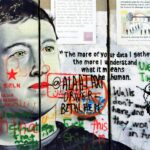Philanthropy Fills the Cracks as We Reopen the Nation
My wife has a theory. Even if you’re full from a big meal, there is still room for ice cream because ice cream fills in the cracks.
I’m no scientist, but my layman’s experiments so far prove this theory is sound.
Philanthropy is a bit like the ice cream of society, filling in the cracks between business and government. Together, these things all make a unit.
Our culture of philanthropy and civil society is perhaps the most unique and important aspect in sustaining our freedoms. Too many people misunderstand the sector. Our charitable sector isn’t just a feel-good aspect of our lives, nor is it a playground for the rich. It is a critical third leg in the social stool.
Or, if you will, a filler of cracks. And there are a lot of cracks right now.
DonorsTrust president Lawson Bader put it bluntly on a recent conference call to young leaders, saying, “The story of this [COVID-19] is the way a health crisis created a government reaction that created an economic crisis that literally wiped out a third of the planet in terms of opportunities and jobs and creativity.”
Yet we have to bounce back. As our nation recovers and reopens over the next few months after the devastating health and economic effects of COVID-19, philanthropy and the civil society sector have a stepped-up role to play. That means you and I have a major role to play in being part of the solution.
We Need Results
Before we can figure out exactly what problems philanthropy will solve, we need to acknowledge that the “how” will be different for many nonprofits. Like pouring Coke on a corroded car battery, the COVID crisis has stripped the calcification off many organizations. Some took it as a chance to double down and be ready for action. Others were stymied, shell-shocked, and stuck.
Organizations with a clear sense of purpose, strong leadership, and motivated teams tended to jump into action more quickly, pivoting their strategy to address the new problems in front of them.
Our donor dollars need to follow those motivated organizations. We can’t measure success in media mentions and number of people at events any more. If an organization isn’t out there making lives better, it isn’t going to survive this crisis.
We Need Better Ideas
Philanthropy has a role to play not just in feeding people now or nursing them back to health, but also in ensuring the conditions are right for a long-term and sustained return to prosperity. That means supporting the long game of policy organizations and citizen education groups matters as well.
This is a unique moment. Government leadership has a place in the current crisis. At the same time, it’s easy for leadership to become a heavy hand. And let’s not forget the decades of government growth and overreach that created systems and regulations that are actually standing in the way of health and economic recovery.
The state and national think tanks have jumped into action. Many of them have leveraged the crisis to highlight those obstacles strewn on the path to recovery. Competitive Enterprise Institute launched a wide-spread #NeverNeeded campaign to call attention to regulations that elected officials are stripping from the books temporarily and asking why they are the first place (hello, margarita delivered to my door!). The governor of Ohio turned first to the Buckeye Institute when he wanted to understand how to streamline policy to enable recovery, and Buckeye didn’t disappoint.
At DonorsTrust, we launched the Growth & Resilience Project to rapidly deploy dollars to groups such as these offering promising ideas to roll back regulations so our health care, education, and job creating sectors can come out of this crisis stronger. With the support of a number of donors, we’ve given out more than $700,000 to 17 organizations – and, perhaps more importantly, helped catalyze thinking by other groups on what they can do.
We Need Donors To Step Up
Donor engagement is the secret sauce of philanthropy and civil society. A social entrepreneur’s sweat equity only carries so far. Organizations need the donations of time, energy, and financial resources to move forward.
These crises haven’t just shuffled the deck on which nonprofits thrive – the donor community is similarly shaken up. Even with some recovery in the stock market, many donors feel less able to give than a year before. Others bear the brunt of this crisis, including donors in hospitality, travel, and retail.
That does not mean that the donors are gone, however. It means different donors have an opportunity to step up.
I asked former AEI President Arthur Brooks a question recently about his expectations for philanthropy in the coming year. He noted a few wise things to keep in mind. One was that wealth tends to bounce back quicker than income. That means wealthy givers will be in a better position to give later in the year than those smaller-dollar givers who give out of their cash flow.
As a consequence, nonprofits reliant on lower-dollar donors may have a hard time in the second and third quarter. Donors in a stronger position can – and should be encouraged to – mitigate that dip by giving. Arthur called it a “double tithe.”
One thing I have learned in years working in philanthropy is that there is no shortage of funds out there, even in bleak times. However, the source of those funds shifts from time to time. Organizations with a bold vision can find the money. It just may not be where they used to look.
We Need You
No one likes to be told what they “should” do. That is why I intentionally call this an opportunity. Are you in a position to be one of those donors that does a little more?
Philanthropy has no age or income requirement. Anyone and everyone can be a charitable giver. More than that, anyone can be a philanthropist, which I define as someone who is strategic about how they give.
Right now, there are so many cracks in society looking for bold action. We can’t wait for government to fill in those gaps, and business isn’t always the right answer. Instead, we can smooth out the rocky road ahead with action from the philanthropic and civic sector. We truly can emerge from this stronger. Just jump in.




